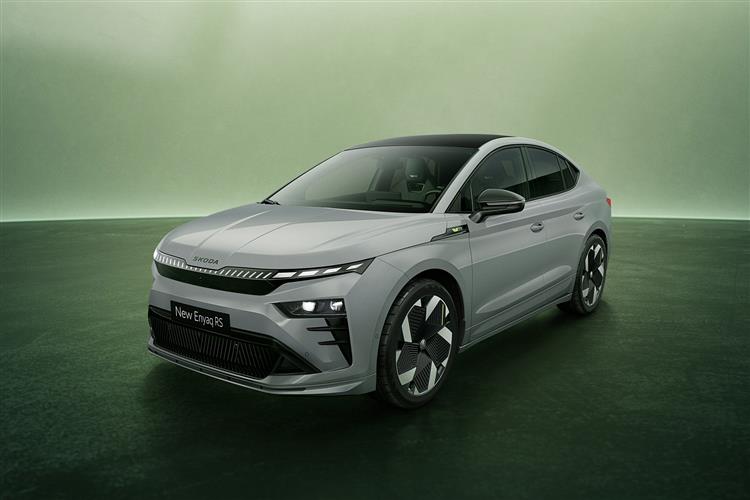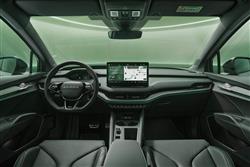PLUGGING AND PLAYING (some text hidden) --NONE--
By Jonathan Crouch
Skoda's priciest model, the sleek Enyaq Coupe vRS, has its own brand of value. Jonathan Crouch looks at the latest version.
Ten Second Reviewword count: 38
In top vRS form, Skoda's Enyaq Coupe is desirable but pricey. But in this updated guise, that asking figure for this 340PS vRS AWD performance flagship model might seem a little easier to justify. Let's take a look.
Backgroundword count: 152
British buyers have always liked Skoda's vRS performance badge. The Czech maker even calls this 'a love affair'. Well that affection has been tested by this car, the Enyaq Coupe vRS. At its original launch back in 2023, it was by far the priciest Skoda the brand had ever brought to sale, taking the fast EV mechanicals we'd already seen in top versions of Volkswagen Group mid-sized Crossover coupe electric vehicles like the Volkswagen ID.5 and the Audi Q4 Sportback e-tron. This Skoda though, delivered them with more of a performance vibe. Fast forward to Spring 2025 and we got the updated Enyaq Coupe vRS model we're going to look at here. The front end look's a little different and the battery powertrain's slightly tweaked but essentially, everything's still much as it was - and this Coupe vRS model sells alongside a slightly cheaper SUV vRS variant. Let's take a closer look.
Driving Experienceword count: 264
This Enyaq Coupe vRS model's dual motor AWD powertrain is exactly as before, with 340PS and 545Nm of torque. As a result, this vRS takes only 5.4 seconds to sprint to 62mph, on the way to a limited top speed of 111mph. In this updated form, the vRS features a marginally bigger 84kWh battery, 79kWh of which is usable, but EV range hasn't changed much, up slightly from 336 to 340 miles. As before, driving dynamics are enhanced by a progressive steering system and a sport chassis that lowers the front axle by 15 millimetres and the rear axle by 10 millimetres. Sports tyres also come as standard, as does a DCC adaptive chassis system that now has a more dynamic damper set-up compared to the previous version and features 15 settings for damper stiffness. The car's 'Driving Mode Select' drive mode system offers a special traction mode tailored to the all-wheel drive. And this vRS variant has more powerful brakes on the front axle, with two-piston callipers. Two external sounds, Sport and Futuristic, are assigned to the different driving profiles or can be selected in Individual Mode via the infotainment menu's driving profile option. On the road, expect traction to be impressive at speed through corners, but there's a little more body roll through the turns than you'd get with the alternative Volkswagen and Audi versions of this VW Group design. The pay-off for that though, is a much better standard of ride, with suppleness over poor surfaces and speed humps that's un-bettered in this class and is far superior to most rivals.
To see the full road test text contact us on 0330 0020 227
Pictures (high res disabled)

.jpg)
|
.jpg)
|
.jpg)
| |||
.jpg)
|
.jpg)
|

|
Statistics (subset of data only)
Min |
Max |
|
Price: |
£53,560.00 (At 23 May 2025) |
|
Max Speed (mph): |
111 |
|
0-62 mph (s): |
5.4 |
|
Electric WLTP-Rated Driving Range (miles): |
340 |
|
Length (mm): |
4652 |
|
Width (mm): |
1877 |
|
Height (mm): |
1622 |
|
Boot Capacity (l): |
570 |
|
Power (ps): |
340 |
|
Scoring (subset of scores)
Category: Hybrid, Plug-in, Electric & Hydrogen
| Performance | |
| Handling | |
| Comfort | |
| Space | |
| Styling, Build, Value, Equipment, Depreciation, Handling, Insurance and Total scores are available with our full data feed. | |



